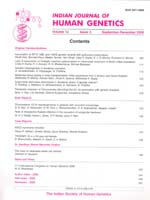
|
Indian Journal of Human Genetics
Medknow Publications on behalf of Indian Society of Human Genetics
ISSN: 0971-6866 EISSN: 1998-362x
Vol. 10, Num. 2, 2004, pp. 81-82
|
Indian Journal of Human Genetics, Vol. 10, No. 2, July-December, 2004, pp. 81-82
Letter To Editor
Is this cystic fibrosis?
Sehgal Arvind
Grace Neonatal Intensive Care Unit, The Children's Hospital at Westmead, Westmead, Sydney, NSW
Correspondence Address: 54, P. O. Box 293, Wentworthville, NSW 2145,
jyotiarvind@hotmail.com
Code Number: hg04019
Sir,
A baby boy born to a primigravida mother at 34 weeks gestation was referred on day 2 with abdominal distension and pneumoperitoneum & abdominal calcification on abdominal X-ray. Antenatal history was uneventful. He was suspected to have meconium ileus with perforation and meconium peritonitis. Laparotomy showed ileal perforation and meconium pseudocyst and he underwent end to end anastomosis. His newborn screen (NBS) done on day 3 showed elevated Immuno- Reactive Trypsinogen (IRT)-400 mmol/L (normal 70-80). Screening for alpha 1 anti-trypsin was negative. Since cystic fibrosis was suspected, deltaF508 and deltaI507 mutations were tested and were absent. He underwent extended panel of CFTR mutations (G58E, 621+1G ®T, R117H, Y122X,711+1G ®T,1078delT, R347P,R347H, R334W,A455E,Q493X,V520F,1717-1G ®A,G542X,G551D,R553X,S549N,S549R, R560T,1898+1G ®A,2183AA ®G,2789+5G ®A, 3849+10KbC ®T,3849+4A ®G,R1162X,3659delC,W1282X, 3905insT and N1303K), incorporating a multiplex PCR oligonucleotide ligation assay. All of these were absent. Sweat chloride test done at 9 weeks was normal (Chloride 5 mmol/L). There was no increased incidence of infection.
Clinical scenario highly suggestive of CF and high IRT levels, in absence any genetic diagnosis posed a diagnostic dilemma. This panel accounts for approximately 85% (out of which 77% are delta F508) of Cystic Fibrosis Transmembrane Conductance regulator (CFTR) mutations in Australian population,[1] though even such an exhaustive screen is likely to miss about 15% cases. Cystic fibrosis is one of the most common life-threatening autosomal recessive disorder, affecting 1 in 2000-3000 Caucasian births.[2] It is caused by mutations in the CFTR gene and the most common mutant allele is deltaF508, which is responsible for 2/3rd cases.[3] The frequency of deltaF508 in Indian population is about 19%.[4] There is great mutational heterogeneity in the remaining third. CF is perhaps the epitome of mutational diversity as nearly 1000 CFTR alleles have been identified to date (www.genet.sickkids.on.ca/cftr). Some are present in specific populations or at variable percentages in different populations while some mutations (like 3849+10KbC ®T) do not cause changes to sweat chloride.[1] Information on all mutations that have been published were reviewed and integrated into a centralised database, which confirmed wide mutational heterogeneity throughout the world. It was recommended that multiple CFTR alleles should be included to increase sensitivity of NBS programs employing two-tier testing with IRT analysis first and then, if level is high, DNA multiple (CFTR) analysis be done.[1] Achieving high sensitivity in prenatal and neonatal screening requires knowledge of regional ancestry and/or CFTR arrays. Screening programs that rely on detection of a small sub-population of mutations are destined to have an internal bias. In conclusion, the frequency of most CFTR mutations is highly variable and is often a function of the ethnic or geographic origin of parents and grandparents of affected child.
REFERENCES
| 1. | Bobadilla JL, Macek M, Fine JP, Farrell PM. Cystic Fibrosis: A Worldwide Analysis of CFTR Mutations- Correlation with incidence data and application to screening. Hum Mutat 2002;19:575-606. Back to cited text no. 1 |
| 2. | Farrell PM. Improving the health of patients with cystic fibrosis through newborn screening. Adv Ped 2000;49:79-115. Back to cited text no. 2 |
| 3. | Estivill X, Bancells C, Ramos C, Biomed CF. Mutation Analysis Consortium. Geographical distribution and regional origin of 272 cystic fibrosis mutations in European populations. Hum Mutat 1997;10:135-54. Back to cited text no. 3 |
| 4. | Kabra SK, Kabra M, Lodha R, Shastri S, Ghosh M, Pandey RM, et al. Clinical profile and frequency of Delta F508 mutation in Indian children with cystic fibrosis. Indian Pediatr 2003;40:612-9. Back to cited text no. 4 [PUBMED] [FULLTEXT] |
Copyright 2004 - Indian Journal of Human Genetics
|
